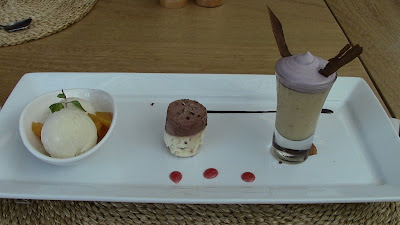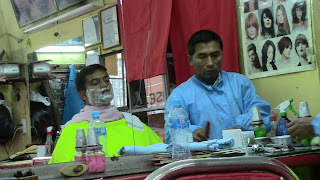That's when I woke up three days ago to catch a flight into the jungle. The driver took me bleary-eyed to the airport in La Paz where I boarded a twin propeller plane with no bathroom and just 19 seats to Rurrenabaque at 6:10. That's the jungle hub city where all the tours start.
 |
| Tiny plane |
The truck broke down about 20 minutes away from the port. The driver turned into a mechanic and was working on the truck for a while. Then he asked us to push the car to get it going. We pushed it for about 50m and the truck finally started again. We made it to the port and loaded onto a long boat with an outboard motor on the back. This would be our transportation for the rest of the trip.
It was another three hour ride up the river to the "eco-lodge". The river is teeming with life. Even if you couldn't see animals, you could here them. There were so many birds and you could see bubbles under the water. The alligators and the caiman looked extremely menacing. Our guide assured us the alligators weren't aggressive. Only the caiman were, but they ate other alligators, not humans. There were these beautiful water birds drying themselves out in the sun after diving into the river for fish. We must have passed hundreds of alligators just sunning themselves on the bank of the river. Some were laying with their mouths open to let the warm jungle air heat them up. Pink birds, white birds, black birds, blue, yellow, green, every colour you could think of, there was a bird in the jungle with those feathers. It was fantastic.
We also passed a family of monkeys who were looking for food. Someone on the boat had a banana and the monkeys actually climbed into the boat and onto her to get it. There were also monkeys by the kitchen every morning for breakfast. There's a video of one below. We finally made it to the eco-lodge at around 5pm after leaving Rurrenabaque at 9am. It was a long day, but our guide told us we were going to a special area to watch the sun set. It was gorgeous. But as soon as the sun went down, the mosquitoes came out, so we rushed back to the lodge for shelter and our mosquito nets. On the way back we could see hundreds of bats out for their evening breakfast. Check out the video, you'll have to watch closely.
I think eco-lodge is just a term they use, because there was nothing ecological about this place. The soap and shampoo from the shower just went into the ground. And the empty plastic water bottles just magically disappeared everyday. They just use the term so that you can't complain that you are just living in a pile of sticks with some mosquito netting for windows.
 |
| "Eco-lodge" |
 |
| Mosquito nets over every bed |
That night we went out looking for alligator and other animal eyes. The guide said the alligator's eyes glow red when you shine a flashlight on them because of the membrane over their eyes that allows them to keep their eyes open under water. I couldn't take any pictures of it because my camera isn't good enough. It was an eerie experience shining your camera out into the darkness and being greeted by glowing reddish-orange eyes.
The next morning we woke up to a hearty breakfast and donned knee high boots to go into the pampas. The pampas are a swampy, marshy area in the jungle where anacondas live. Oh yeah, I forgot to mention, we were hunting anacondas. After about an hour an a half, I got tired and tried to head back to the boat. However, the grass was above my head, and I didn't know the exact direction, only the general direction. After about half an hour, I realized I was lost, in a swamp, in the middle of the Amazon. Not a good place to be. After about 15 minutes, I heard the group calling my name, . Needless to say, I was relieved and headed towards them. They had actually found an anaconda about 6 feet long. The pictures were cool. Oh well...next time for me I guess.
Next we headed back to the lodge for some lunch and back out onto the boat for piranha fishing. This wasn't any fancy fishing. It was twine with a hook on the end all wrapped around a piece of wood. Our guide caught the most fish. He has lived in the jungle his whole life.
It was still fun to try and catch these aggressive looking fish. It was a good day's work!
We got up early the next morning to watch the sun rise over the pampas. It was a really cloudy day, so I wasn't sure if we would get any picutres. The clouds cleared and lo and behold. It was a great open sky to watch the sunrise.
 |
| Cloudy morning |
 |
| Pampas sunrise |
 |
| Breakfast Monkeys |
The sunrise was gorgeous and we left soon after because there were so many mosquitoes. After breakfast we went searching for pink dolphins. And we found them. It was cool to jump into the water with them. They never really too close. But it was amazing anyway. Check out the video to see them coming up for air. It was hard to snap their picture because they only came up to the surface for a second and rarely breached the water.
We headed back to camp for lunch and to head home. The boat ride back was shorter than on the way in, and the jeep ride was just as bumpy concussive as ever. I swear that thing was running on bubble gum, duct tape and glue. There were definitely no shocks.
It was a great adventure.






























































